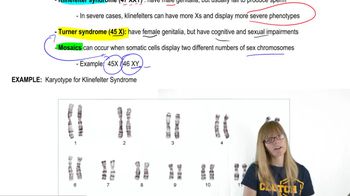In eukaryotic DNA,
where are you most likely to find histone protein H1?
 Sanders 3rd Edition
Sanders 3rd Edition Ch. 10 - Eukaryotic Chromosome Abnormalities and Molecular Organization
Ch. 10 - Eukaryotic Chromosome Abnormalities and Molecular Organization Problem 4
Problem 4Describe the importance of light and dark G bands that appear along chromosomes.
 Verified step by step guidance
Verified step by step guidance
Verified Solution
Key Concepts
Chromosome Structure

Giemsa Staining
Karyotyping

In eukaryotic DNA,
along a 6000-bp segment of DNA, approximately how many molecules of each kind of histone protein do you expect to find? Explain your answer.
In eukaryotic DNA,
how does the role of H1 differ from the role of H3 in chromatin formation?
Human late prophase karyotypes have about 2000 visible G bands. The human genome contains approximately 22,000 genes. Consider the region 5p1.5 through the end of the short arm of chromosome 5, which is identified on the late prophase chromosome in Figure 10.5, and assume the entire region is deleted. Approximately how many genes will be lost as a result of the deletion?
Consider synapsis in prophase I of meiosis for two plant species that each carries 36 chromosomes. Species A is diploid and species B is triploid. What characteristics of homologous chromosome synapsis can be used to distinguish these two species?
From the following list, identify the types of chromosome changes you expect to show phenotypic consequences.
trisomy